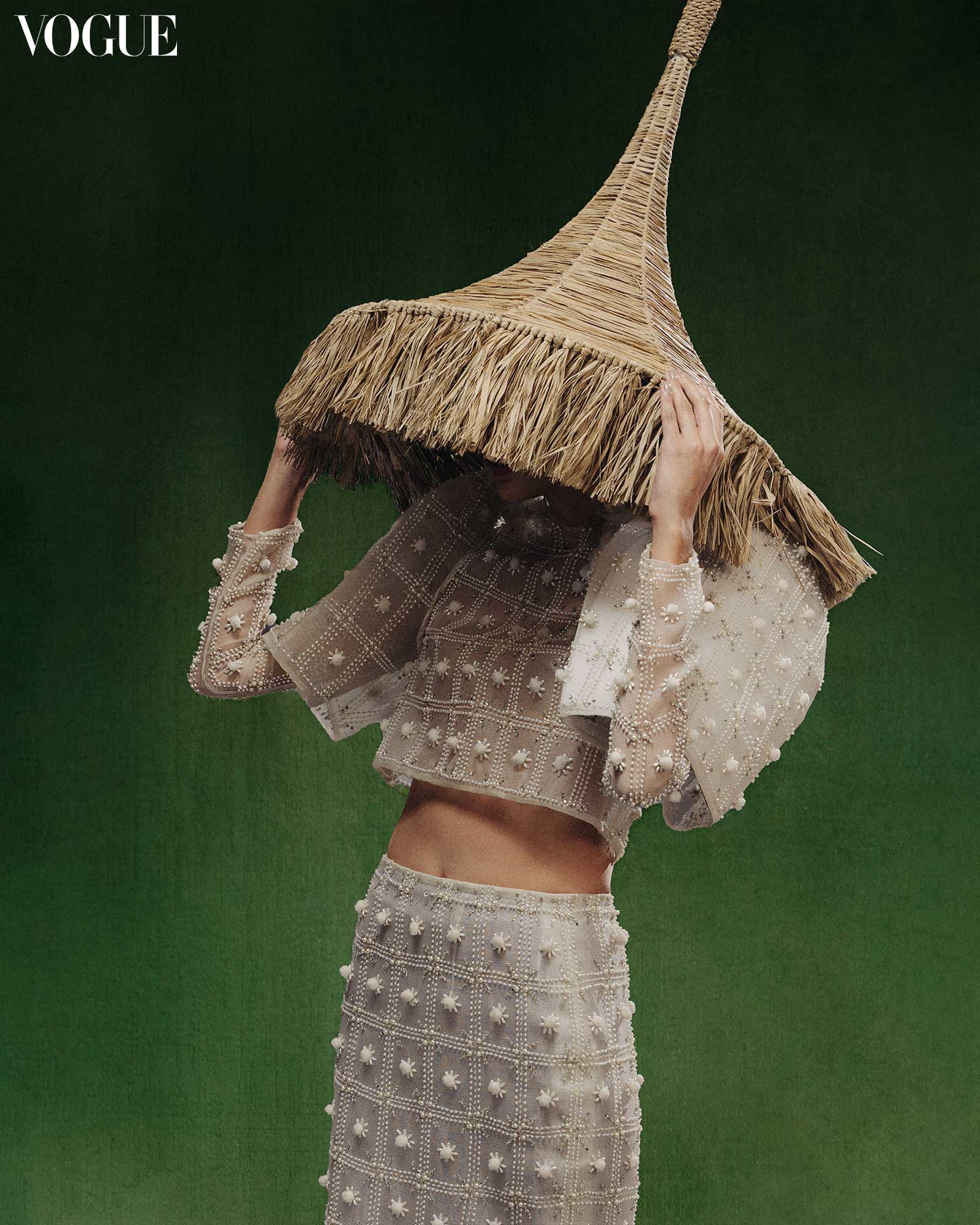
Designers Jojie Lloren, Cary Santiago, Dennis Lustico, Lesley Mobo, Joey Samson, Patis Tesoro, Len Cabili, Rhett Eala, Ivarluski Aserson, and Furne Amato contribute to a portrait of the terno. The Philippine dress or terno is a garment that evolves with the times. It is a reflection of the Filipino’s adaptability in the face of change.
However, it may also be seen as a victim of the times with the Filipino’s incessant impulse to tamper with “heritage” to refashion them into something more delectable for the period. Over the 20th century, the terno underwent a series of subtractions: from the fusion of the three-piece ensemble to a one-piece garment in the mid 1930s, the removal of the sobrefalda (sheer overskirt) as a World War loomed in the late 1930s, removal of the pañuelo (fichu) after the liberation of Manila in the late 1940s, and the disappearance of the sheer butterfly sleeves in the 1950s in favor of opaque material. By the late 1960s, the terno was relegated to formal dress, and young Filipinas avoided it in favor of mini dresses during the youthquake.

After the EDSA Revolution in 1986, the terno practically disappeared. Efforts to revive the terno in the 1990s by the likes of Gilda Cordero-Fernando’s Jamming On An Old Saya and the Cultural Center of the Philippines’ publication Patterns for the Filipino Dress by Salvador F. Bernal and Georgina R.
Encanto kept the dress in the public consciousness. However, they did not necessarily encourage a new generation of Filipinas to wear it though they laid important groundwork for its eventual regeneration. In 2003, the Metropolitan Museum of Manila under the leadership of Ino Manalo, Bea Zobel Jr.
, and Bench mounted an ambitious series of projects to revive the terno. A competition for young designers, a “terno ball,” a fashion show cum tribute for one of the greatest terno designers, Joe Salazar, and a terno exhibit that occupied the entire museum. For a moment, the country saw society women, both young and old, in terno once again.
In 2004, Salazar passed away from throat cancer, with him the demise of the last solid tradition of terno craft. Meanwhile, in an effort to “modernize” the terno and make it relevant for their generation, the rising designers of the period collectively diminished the size of the terno sleeves. From a relatively standard proportion from the 1920s through the 1980s, “teacup” versions of butterfly sleeves emerged, much to the chagrin of the top designers like Inno Sotto.
Despite their good intentions, the young designers unwittingly served the final death blow to the terno, which at this point was “a terno by virtue of the addition of butterfly sleeves” on any dress. Was it the proliferation of baby tees and their barely there sleeves? Was it the lack of relatability of contemporary fashion trends with the conventional proportion of sleeves? Or was it the “shame” that came with being Pinoy wearing grandmother’s dress? Whatever the case may be, the last bastion of the Philippine dress was also on the verge of disappearing in the form of ordinary puff sleeves that lacked a distinct identity. Aside from terno design issues that plagued the local fashion community, misinformation on the history of the terno proliferated.
This situation was partly due to the lack of resources and first hand experiences of how the terno was worn. After all, many of the young designers who grew up in the 1980s and 1990s no longer had the benefit of seeing their grandmothers, mothers, sisters, and a whole community wearing the terno as an everyday garment. For many Filipinos, it was already a mere “costume,” only worn on stage by a folk dance company or an obligatory national day attire.
To address some of these problems, Fashionable Filipinas: An Evolution of the Philippine Dress in Photographs was published by Bench in cooperation with Slim’s Fashion and Arts School. A book launch that required guests to come in formal terno was mounted at the Manila Peninsula’s Rigodon Ballroom in 2015. Women came in traditional and varied contemporary versions of the garment, and the spotlight was on the terno again.
.. at least for the time being.
The following year, a workshop on the Philippine dress was conducted by the CCP’s Production Design Center at the Ateneo Art Gallery in 2016. The project also honored Salvador Bernal’s design legacy and scholarship. Participants were lectured on the history of the Philippine dress based on research from Fashionable Filipinas and asked to enlarge patterns from Patterns for the Filipino Dress.
However, the problems still persisted, and it was for this reason that Fashioning the Terno was conceived as a joint project of the CCP’s Outreach Department and Bench. Regional designers from Luzon were gathered in Vigan, Ilocos Sur for an intensive week of lectures and construction of period patterns in July 2017. The realization of immense wealth of design talents and drive from the regions as well as a hunger for knowledge on the Philippine dress evolved the fledgling project to TernoCon , a terno-making convention and contest that culminated with a historic fashion show and cultural showcase in 2018.
It is also TernoCon’s goal to bridge a gap between the established designers, who serve as mentors and the emerging designers, who enter as mentees. The group is taken through a year-long process that involves endless discussions on the balance between contemporaneity and tradition, reworking of drawings and toiles, and birth pains of creating capsule collections. Ultimately a more personal appreciation and understanding for the Philippine dress is instilled in the process, with love for country at its core.
The movement is largely responsible for a renewed interest in the terno that also resulted in a wider use of the garment especially amongst the youth. It also gave rise to a wide range of contemporary options that were not available until the early 2000s. In short, more choices are now available, and more designers can be approached for RTW or made-to-measure versions of the terno.
The following pages celebrate this diversity of interpretations of the Philippine dress by some of the Philippines’ seasoned designers, headed by Patis Tesoro, who has been at the forefront of promoting Filipiniana and Philippine embroidery since the 1980s. Her creations reflect her ethos of reveling in tradition and embellishment. She is joined by other designers who have served as mentors at TernoCon: JC Buendia, who was primarily responsible for reintroducing a solution to the practical needs of women today by separating the one-piece terno into coordinates with a terno top and matching saya or pants; Philip Rodriguez, a reliable classicist with a solid reputation for terno craft; Dennis Lustico, who stylized the alampay (shoulder cloth) and tapis (a strip of cloth wrapped around the waist) of the humble balintawak (the country version of the terno) into draped forms; Cary Santiago, who is probably the best technician of today with the most playful imagination resulting in sculptural ternos that are actually worn by women beyond the runway shows; Lesley Mobo, a post-modern draper who infuses ternos with palpable emotions and backstories grounded in historical references; Joey Samson, who fuses the languages of traditional menswear and womenswear to create ternos that also straddle historicism and cool, Rhett Eala, whose skill at capturing the zeitgeist (e.
g. early 2000s minimalism) was reflected in his first terno inspired by painter Lao Lianben; Ivarluski Aseron whose obsessive construction skills resulted in ternos inspired by the banig (woven mat); Jojie Lloren, a master of form and construction whose design school has also developed its own technique in pleating the butterfly sleeves, and Len Cabili who was at the forefront of slow fashion and integration of several indigenous crafts into terno design. Furne Amato caps the list with a maiden terno that serves as a testament of Amato Couture’s high level of craftsmanship.
By reflecting the times and infusing their creations with their unique perspectives, these contemporary designers have invigorated the terno. They have also tapped into a continuum, a mystic cord of Filipino memory that includes works by Pacita Longos (1920s), Pura Escurdia (1930s), Ramon Valera (1930s to early 1970s), Salvacion Lim (late 1940s to 1980s), and many unsung modistes and designers, thereby imbuing the terno with the respect and dignity worthy of a national garment. Jojie Lloren Jojie Lloren’s education as a fashion visionary began not in university or during his time in Paris, but while tailing his mother and aunts during their fittings as a young boy in the ’70s.
He’d listen to them articulate their needs and watch in awe at how empowered the clothes made them feel. Through the years, and especially when he was working on the pieces for “A Lullaby for my Mother,” Lloren shares that his late mother Herminia Tuazon as well as his sister “are the driving force for me to do my best in my undertakings.” To love is to pay attention, and Lloren innovates the terno with the couture construction he is known for, crafting butterfly sleeves as raglans for the ease of today’s busy, modern woman, letting tradition and heritage—much like a supportive family—become a source of strength.
He transforms his grief with the humble muslin and fallen leaves and bird feathers from his Pasay home; with meticulous tufting and hand-painting, he creates beauty out of the ordinary. Cary Santiago The bold red stripe of the Philippine flag stands not only for patriotism but also valor: two values that Cary Santiago lives by. Taking Philippine fashion design to great heights, literally with his shape-defying sculptural creations and figuratively as one oftheFilipinodesignerswhoupheldour heritage of craftsmanship globally from the Middle East, Santiago took it upon himself to celebrate our visual culture for TernoCon 2024.
The terno’s distinct silhouette is as emblematic of the Philippines as much as the jeepney, the Philippine eagle, and the colors of the flag. He thought, why not celebrate them all at once? “Ikonograpiya” is his most bold collection yet. Known for his fabric tiling appliqué technique, the Cebu-born designer transcends the possibilities of what the terno, balintawak, and kimona could be, taking on the technical and visual challenge of turning the likeness of our national hero Jose Rizal and an intricately-crafted bahay kubo as wearable art, pushing the limits of his mastery of laser-cutting, handiwork, and precision pleating.
It’s impossible not to wear it with Filipino pride, just as Santiago intended. Dennis Lustico The balintawak shined brightly in Dennis Lustico ’s TernoCon 3 collection. Traditionally, the ensemble features four components: the camisa (blouse), alampay (kerchief), saya (skirt), and tapis (waist cloth).
Intended as casual wear for the countryside, it shows a softer, more playful side of the terno. At Tokyo Fashion Week, models walked the runway wearing contrasting hues; vibrant shades of green, orange, and pink alongside softer blues and violets, reflecting the diversity of Philippine scenery. Lustico also introduced longer sleeves beneath the traditional butterfly sleeves, inspired by rice farmers shielding themselves from the sun.
“I’m a very outdoorsy person,” the acclaimed designer reflects. “What I see when I go hiking and running, what I feel when I’m among trees and open fields influences my creative process. Colors, patterns, textures, movements, and shapes of everything that breathes inspired me to create a vibrant and festive collection.
” The feeling of the wind as it blows, the brilliance of daytime, and the forms of flora are conveyed through intricate embroidery, pleating, and draping. Lesley Mobo Initially, Lesley Mobo was not interested in doing ternos. “ Pinilit ko pa siya ,” [I even had to force him] recalls Gino Gonzales, TernoCon artistic director.
Born in Aklan, educated in London, and thriving between there, Paris, and Manila, Mobo was eloquent in the European verve, fashioning decadent textiles with liquid drapery. While reading Fashionable Filipinas (which Gonzales co-authored with Mark Lewis Higgins), he found himself fixated on a 1910 image of fully decked out pillow vendors at the port of Cebu. He thought that Filipinos were always leaving—running away from the Spanish, from the Japanese, from the Americans.
When he first unveiled his collection at TernoCon 2020, another “brain drain” challenged the healthcare industry. A Catholic scapular is right next to a sequined anting-anting and panakot sa aswang red pouch with heart-shaped paillettes, all hand-embroidered by the famed Hand & Lock in London as a coming together of two parts of Mobo’s life. Generations later, the Filipino diaspora still carries that proverbial tampipi, bursting at the seams.
The modernization of the terno has allowed them to reconnect with their origins, wherever in the world they may be. Joey Samson Joey Samson referenced the work and romances of Jose Rizal for his collection in last year’s TernoCon. “‘Ang Mga Pag-ibig ni José Rizal’ drew inspiration from personae in the Philippine national hero’s life, including the real, fictional, and metaphorical,” shares Samson, who was a mentor for the competition.
His designs were showcased at three events: TernoCon 3, Bench Presents TernoCon at Rakuten Fashion Week Tokyo, and Paskong TernoCon. Each show expanded his universe of characters, culminating in more than 20 looks that brought Rizal’s influence to life. Alongside history and literature, the designer expertly plays with contrasts, blending Western and Eastern elements.
One look, presented in Tokyo and inspired by O Sei-San—Rizal’s Japanese lover—merges the Filipino, European, and Japanese with butterfly sleeves, deconstructed suiting details, and a vintage obi sash. Another design pays homage to sweetheart Leonor Valenzuela, atop a pleated skirt resembling stacked pages is a camisa with tuxedo detailing. The collection also bridges the feminine and masculine by integrating traditionally women’s garments, such as the pañuelo and tapis, with menswear.
Notably, an outfit named after Rizal is worn on a female model dressed in a grayscale terno, trousers, Chinese slippers, and a top hat. Patis Tesoro Love keeps the terno alive. Before its revival in the 2010s for occasionwear, the last stronghold of the Filipiniana was wedding gowns.
Filipino fashion as we know it wouldn’t be the same without Patis Tesoro , a true rebel and pioneer. She has made championing our national dress her life’s work, from creating baro’t saya for everyday and the piña revival of the ’90s to advocating for the last remaining embroiderers and beaders and keeping Philippine textile heritage alive with upcycling from her garden home in Laguna. Her archival work, especially her wedding gowns, remain instrumental to Filipino fashion.
All designed and made completely in-house, the modern baro pictured here is fashioned out of sturdy French lace and beadwork for bride Lyn Lopez Medina in the 1980s. It demonstrates the sophistication, passion, and creativity of our artisans. To Tesoro, this is upholding embroidery as “our forefathers had worn them”: in full splendor, like the warm embrace of well-wishers.
Rhett Eala In 2003, the Metropolitan Museum of Manila held a tribute show for Joe Salazar, the legendary Filipino courtier celebrated for his mastery of the terno. Rhett Eala, distinguished designer then known for his work with Rustan’s Dué and his label Wink, was among the designers tasked with creating ternos in Salazar’s honor. At the time, Eala still had limited experience with the national dress, which waned in popularity and still carried the stigma of its association with Imelda Marcos and Martial Law.
Designer JC Buendia guided him in crafting the butterfly sleeves, and his tailors helped him with the garment’s structure. Eala created two ternos for the occasion: one in black and another in white. Eala splattered both with paint—the white gown with black and the black dress with gold.
“Since it was being held in a museum, why not paint on the terno?” he shares. The paint was then embellished with matte sequins and cut beads. Years later, after the original was lost, Eala recreated the ivory terno at Gino Gonzales’ request, this time with larger sleeves to better highlight its importance.
A sign, perhaps, of its resurgence today. Ivarluski Aserson Just as all Filipinos recognize a banig, the traditional Philippine woven mat, Ivarluski Aseron is well-known in the industry for incorporating these mats into his designs. In 2020, when he was mentoring for TernoCon, Aseron celebrated the banig in his Filipiniana collection “Himlay,” which means “lay to rest.
” “In olden times, the banig and kulambo (mosquito net) were sleeping essentials,” explains the designer. Banigs are traditionally made with palm or tikong leaves that are dried, dyed, cut into strips, and woven into patterns. Around the country, these patterns are passed down through generations.
Aseron honors this rich craft by substituting leaves for laser-cut gazar in shades of ivory and black, translating these motifs onto fabric. The fringe detailing on his pieces brings to life a transitional phase of banig-making, when the edges are yet to be finalized by an artisan. “We left raw edges to emphasize that the banig fabric was hand-woven,” shares Aseron.
His innovative fabric manipulation results in garments that feel sculptural, with proud butterfly sleeves that convey a sense of strength, fortified by the intricate weaves. Furne Amato The terno has become what it is today because of the collective ingenuity of the designers and artisans who came before. Furne Amato rises to the occasion.
One made a name for himself as a designer and founder of Amato Haute Couture in Dubai for over two decades. His creations elevate the women who wear them—even the stellar Beyonce and Lady Gaga—into celestial beings with his signature beading and command for exaggerating historical silhouettes into fantastical shapes. He never once forgot his roots, integrating Filipino materials like abaca, local jute, and piña when he could.
Now back in his hometown Cebu, the ornate grandeur of its churches and altars inspire his take on the terno. Amato was never one to conform to tradition, but there are some non-negotiables, like the dimensions of the terno’s most distinct, identifying feature: its butterfly sleeves. One masterfully plays with scale and proportion in his fully embellished interpretation, giving us a glimpse into the future of our national dress.
Len Cabili Len Cabili , founder of the brand Filip + Inna , served as a mentor for TernoCon 2018—the national convention and competition focusing on the Philippine dress. Her collection, named “Talang Silangan,” showed 11 ternos inspired by the women of Philippine folktales. “From the clothing and accessories that they wore, we employed traditions in embroidery, beadwork, and textile that display the diversity and richness of the Philippines,” Cabili explains.
Artisans nationwide contributed to this collection. Tausug, Tboli, Lumban, and Bulaceño craftsmen embroidered the garments; Manobo Ubo artisans dyed fabric; and materials were sourced from Ifugao, Basilan, Kalibo, Ilocos, and Bulacan. A signature piece, the Alegria terno, was initially created in 2016 in a collaboration with Balay ni Atong, a social enterprise that produces Inabel textiles by Ilocano artisans.
This blue and ivory terno features a siete cuchillos saya (seven spearheaded panel skirt) and was originally designed with raglan sleeves and a high collar before being redesigned to include butterfly sleeves two years later. “The Alegria terno represents the three major islands of our archipelago,” shares Cabili. “Inabel fabric from Luzon, shell beads from the Visayas, on a beadwork pattern inspired by the Maranao inlay of Mindanao.
”.














